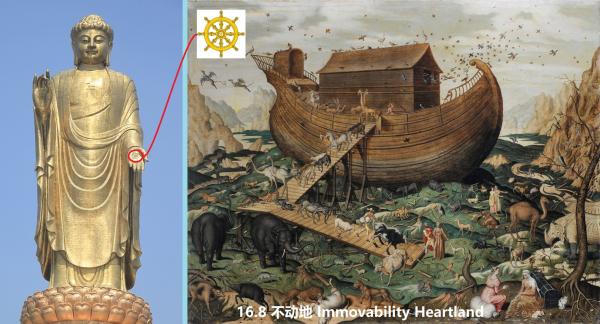16.8 不动地 Immovability Heartland
唐三藏说,不动地者,无分别智任运相续,相用烦恼不能动故。另有说法,前意识能辨别善恶美丑,引发很多烦恼,而此地的大菩萨处于空中,前意识遇空则止,名为不动,所以烦恼不现行。
Tang Tripitaka said, non-discriminative intelligence is in operation at will continually, so phenomenal annoyances cannot move, hence name of Immovability Heartland. Another saying, pre-consciousness can discriminate between good and evil, beautiful, and ugly, which triggers a lot of annoyances, whereas the great Bodhisattvas here are in the empty, and the pre-consciousness stops when it encounters empty, which is called immobility, so the annoyances are not active.
读者可能会有疑问,前意识不动,此人没有意识,这状态就只有解脱的价值了?佛说话的时候,就已经从涅盘里出来了,就有意识了。据说,佛的这个涅槃是建立在前意识里的,名作无住涅槃,用而常寂。
Readers may have questions, if the preconscious does not move, then the person has no intent-sense (i.e. consciousness), then this state has only value of liberation? When the Buddha spoke, he had already emerged from nirvana and became conscious. It is said that the Nirvana of Buddha is established in the preconscious, is called Non-Dwelling Nirvana, and is always functioning and peaceful.
16.8.1 愿渡 Will Ark
菩萨登上八地后,成为了摩诃萨,即大菩萨,继续修习愿渡。愿渡就是菩萨登入初地时许下的四宏誓言:众生无边誓愿度,烦恼无尽誓愿断,法门无量誓愿学,佛道无上誓愿成。愿渡以欲、胜解、和信为性,可分为二种:求菩提愿,利乐他愿。也有说愿渡以拣择法为性。
After the Bodhisattva ascends to the eighth land, he or she becomes a Mahasattva, that is, a great Bodhisattva, and continues to practice Will Ark. Will Ark is the four great vows that the Bodhisattva made when he or she entered the first land: Sentient beings are edgeless, I vow: I ferry them all! Annoyances are endless, I vow I sever them all! Juristic doors are limitless, I vow I study them all! Buddha’s path is non-upper, I vow I endeavour to succeed! Will Ark is by desire, victorious interpretation, and faith as nature, and can be divided into two types: the wish to pursue enlightenment, and the wish to benefit please others. Also having the saying that Will Ark is by selective law as nature.
16.8.2 无相中作加行障 Hindrance of Extra Effort on Non-Phenomena
八地菩萨断无相中作加行障。谓所知障中俱生一分令无相观不任运起。前之五地有相观多无相观少。于第六地有相观少无相观多。第七地中纯无相观,虽恒相续而有加行。由无相中有加行故未能任运现相及土。如是加行障八地中无功用道。故若得入第八地时便能永断。彼永断故得二自在。
Eighth land Bodhisattvas break off the Hindrance of Extra Effort on Non-Phenomena. The saying is that among Know Hindrances, a First Quadrant aggregately born has the “non-phenomenal view” not operated at will. On the fifth land, non-phenomenal views are less than phenomenal views. On the sixth land, non-phenomenal views are more phenomenal views. On the seventh land, even though the pure non-phenomenal views are constantly succeeding, with extra efforts. Because of extra effort among non-phenomena, so presenting phenomena and bodily soil (i.e. bodily feeling) are not operated at will. Thus, extra effort hinders “Non-Function Non-Usage Path” of the eighth land. Therefore, when Bodhisattvas enter the eighth land, can sever that hindrance off, hence self-sufficiencies on presentations of phenomena and bodily soil.
由斯八地说断二愚及彼粗重。(一)于无相作功用愚,(二)于相自在愚;令于相中不自在故,此亦摄土相一分故。八地以上纯无漏道任运起故三界烦恼永不现行。

16.8.3 不增减真如 Neither Increase nor Decrease True Suchness
八地菩萨证得无增减真如。玄奘说,此真如离增减执,不随净染有增减。又,此真如亦名相土自在所依真如,谓若证得此真如,已于现相现土俱自在故。此真如一方面说明了,无意识对多、少、你、我、他、她、它、生、和死、都没有执着;另一方面表明了,被消灭劣种的必要功能会被净种替补。那么什么是净种?
Eighth land Bodhisattvas testify and gain Neither Increase nor Decrease True Suchness. Tang Tripitaka said, this true suchness is free from obsessions of increment and decrement, does not increase or decrease along purification and contamination. Furthermore, this true suchness is also called the “True Suchness Depended by Self-Sufficient Phenomena and Soils”; the saying is that, upon testifying and gain of this true suchness, bodhisattva is self-sufficient on both presenting phenomena and presenting bodily soils. On the one hand, this true suchness shows that unconsciousness has no attachment to more, less, you, me, him, her, it, life, and death; on the other hand, it shows that the necessary functions of the eliminated inferior seeds will be replaced by immaculate seeds. So, what are the immaculate seeds?
人脑思维在处理客观事物的过程中,总是自主地简化客观对象,抽取各类默认模特,如人、蝴蝶、树等。此默认模特,人、蝴蝶、树等都是净种;然后以此默认模特来认知其它同类个体。比如女人,我们看见个体女人会描述大眼睛,高鼻梁,高个子,有点儿瘦等。这些描述都是人脑通过把对方和自己思维机制里的默认女人模特进行比较而采集出的特征,以此来认知对向,乃至所有的女人。
In the process of dealing with objective things, human brain always simplifies the objective objects autonomously, and extracts all kinds of default models, such as woman, man, butterfly, tree, and so on. The default models are “immaculate seeds”, then used to recognize other individuals of the same kind. For example, when we see an individual woman, we might describe her as having big eyes, a high nose beam, tall, and a bit thin. These descriptions are the characteristics that human brain picks up by comparing the objective person with the default woman model in its own thinking mechanism, to recognize the objective individual woman, or even all women.
此中,默认的女人模特就是女人的定义,即女神。人脑通过女神这个模特来建立其它的女人,也就是说所有的个体女人都是从女神派生出来的,即女神是女人的种子, 能生出其它女人。同理,我们可以得出男神是男人的种子,能派生出所有类似的男人;蛇神是蛇的种子,能派生出其它的蛇;树神是树的种子,可以生出很多树,等。这就有了大洪水之后,许多动植物没有绝种的画面(如图16.8右)。
In this case, the default woman model is the definition of woman, i.e., Goddess. Human brain creates other women through adding traits to the default woman model, and so on, all individual women are derived from Goddess, which is saying Goddess is the seed of woman, give birth to other women. Similarly, we can conclude that the male god is the seed of the man, which can give birth to all similar men; the snake god is the seed of snake, which can give rise to other snakes; tree god is the seed of tree, which can generate many trees, and so on. This shows that after the great flood, many animals and plants did not become extinct (right in Figure 16.8).
??返回总第16章道谛的目录??Return to Content of Chapter 16 Path Crux.
